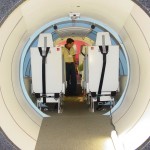By S. Clayton Moore
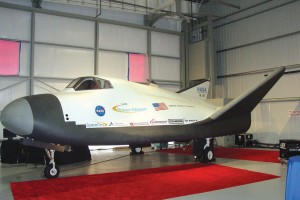
SpaceDev brought its full-size mock-up of the Dream Chaser spacecraft to Centennial Airport as part of its presentation to NASA.
It’s not every day that someone brings a genuine spaceship to town. But that was the order of the day at Centennial Airport on June 21 as SpaceDev, a Pomona, Calif.-based developer of futuristic space technologies, unveiled its entry for a highly competitive NASA project.
The company and its select team of partners, including Colorado-based Adam Aircraft, have been chosen as one of six finalists for NASA’s Commercial Orbital Transportation Services Demonstration solicitation. The $500 million, five-year contract will allow the winner to construct and operate for NASA a next-generation spacecraft designed to transport cargo and up to six crew members to the International Space Station. The station is scheduled to be completed by 2010.
SpaceDev has emerged in this final round of selection from a field of more than 25 contenders. Its entry is the Dream Chaser, a surprisingly small and nimble entry into the field, largely based on the 10-passenger HL-20 Personnel Launch System originated by NASA’s Langley Research Center.
At just 45 feet wide and 30 feet long, Dream Chaser resembles a mini space shuttle and will launch the same way, vertically atop a stack of hybrid rocket engines. Small enough to fit inside the payload bay of one of NASA’s aging space shuttles, it’s expected to make runway landings on its return to earth.
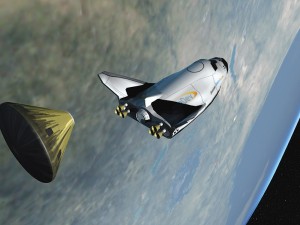
The Dream Chaser is designed to use internal hybrid rocket motors and to launch vertically from a simple launch pad at any commercial spaceport.
The event at Centennial Airport was a precursor to a visit from the selection team from the National Aeronautics and Space Administration scheduled for June 22 and 23. The government entity has indicated that a winner is expected to be chosen this summer. Other finalists include Andrews Space, Rocketplane Kistler, Space Exploration Technologies, Spacehab and Transformational Space Corp.
The VIP presentation was held at Adam Aircraft’s hangar 11 at APA. A full-fledged Dream Chaser mock-up body was exhibited, along with a significant display of flight hardware from the Dream Chaser team members. Adam will build the spacecraft’s carbon-fiber body, a task for which the company is uniquely qualified after building the Adam A500 turboprop and A700 Adam Jet.
Other team members include The Aerospace Corporation, Emergent Space Technologies, Oceaneering, BAE Systems and Starsys, a Boulder-based division of SpaceDev that specializes in moving components on satellites and other space-based systems.
“We’re thrilled,” said SpaceDev CEO Mark Sirangelo. “This is a once-in-a-lifetime opportunity to not only create a program that’s able to pull in the history and heritage of NASA and to work with some really great people in the government, but also to apply a commercial technique to it. There’s a whole world of technology out there that can be enabled if we can get a system like this one off the ground.”
SpaceDev certainly has experience. One of the company’s claims to fame was creating the rocket motors that propelled Burt Rutan’s SpaceShipOne to win the X Prize in 2004. The innovative project created the first privately-funded, manned spacecraft to reach outer space in 2004.
Sirangelo was appointed CEO of SpaceDev in 2005 but had been working with the company as a major advisor for several years beforehand. He was also an early advocate of Rick Adam’s entrepreneurial project to create a new aircraft company to compete in the very light jet market.
“I was involved very early on in Adam Aircraft as an investor and advisor and member of the board,” Sirangelo recalled. “Adam is a company that really knows composites and is also an entrepreneurial company in Colorado, so there’s a nice connection between those concepts. Our teams have gotten along really well because we’re basically the same kinds of people. We really like each other and they understand their role in the project.”
In fact, one of the great advantages of the Dream Chaser proposal is that many of the spacecraft’s components are expected to be based on real, existing technologies like Adam’s carbon-fiber body.
“That’s the point I’m trying to drive home,” Sirangelo said. “The reason for this event is to show that there’s a reality to our project. A lot of new programs only exist on paper. What we’re trying to show here is that the Dream Chaser is not just on paper. We’ve invested millions of dollars already to get this spacecraft to where it is and we’re going to continue down that road regardless of the NASA contract.”
SpaceDev projects a number of viable uses for Dream Chaser even if the spacecraft isn’t ultimately selected for the COTS program. Potential applications include commercial use, such as space tourism flights from New Mexico’s burgeoning $225 million spaceport, or even military applications such as the U.S. Marine Corp’s futuristic “Hot Eagle” program, which envisions delivering a strike team anywhere in the world within two hours via a modified spacecraft.
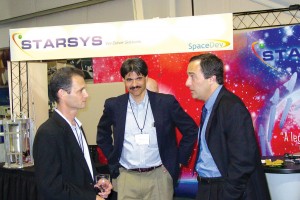
Mark Sirangelo (far right) discusses the Dream Chaser spacecraft with team members from Oceaneering International, Inc.
“We developed this long before there was a NASA project,” Sirangelo affirmed. “A lot of people have laid their hands on this project to move it forward and we’re not stopping now. The next step is to start building it. We’ve just built a new launch test facility for the rocket motors, and the lifting body is a lot clearer.”
NASA administrators aren’t yet commenting on individual applicants for the COTS project but note the groundbreaking nature of the project.
“This initiative establishes a precedent,” said NASA Deputy Administrator Shana Dale at the 9th Annual Commercial Space Transportation Conference in March. “For the first time ever, NASA is seeking nongovernmental vehicles and commercial services to provide these capabilities for human spaceflight.”
Sirangelo praised the NASA administrators for their clear vision and efficiency during the competition phase.
“I think that NASA doesn’t always get the credit it deserves,” he said. “It’s popular to start bashing government agencies for what they do. Our experience—win, lose or draw on this contract—is that they’ve done a great job in delivering what they promised, which is to enable emerging space companies and give them a chance to get their ideas to the forefront. They’ve been highly interactive, they’ve streamlined the proposal process, and they’ve tried to tone down the rules so we could all afford to pursue this goal. Whether we win or lose, I’d like people to know that NASA has done a terrific job here.”
In addition to representatives from each of Dream Chaser’s team members, the event also drew members of Colorado’s general and corporate aviation communities and representatives of Colorado’s elected officials. The project has significant economic impact as it’s anticipated to bring 200 to 400 additional jobs to the state if SpaceDev is successful.
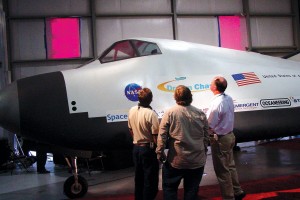
Engineers from SpaceDev check out the Dream Chaser spacecraft during a VIP event at Centennial Airport.
Senators Wayne Allard and Ken Salazar and Congressman Mark Udall all sent letters of congratulations.
“I’m proud that Colorado is home to a company with the capacity to compete in this technologically challenging competition,” Udall said. “As SpaceDev knows, our state is no stranger to the space industry. It ranks third nationally in space-related business and we can point to numerous NASA and DOD success stories.”
Senator Wayne Allard offered his praise as well.
“I have no doubt that NASA has selected this project due to the hard work and the vision of this development team,” he said. “While we honor today’s success, we also look forward to the future, knowing that the Dream Chaser team’s commitment to the tradition of excellence will lead to many more scientific innovations and contributions.”
- Guests were invited to climb aboard the Dream Chaser model to imagine what the spacecraft might eventually be like.
- The Dream Chaser design is largely based on NASA’s previous HL-20, a conceptual design for a 10-passenger spacecraft.
For more information about SpaceDev and the Dream Chaser project, visit [http://www.spacdev.com].












